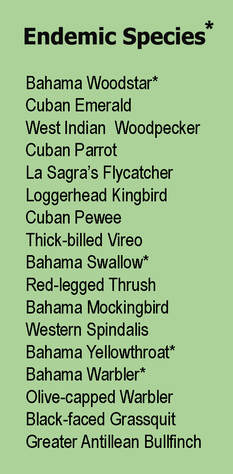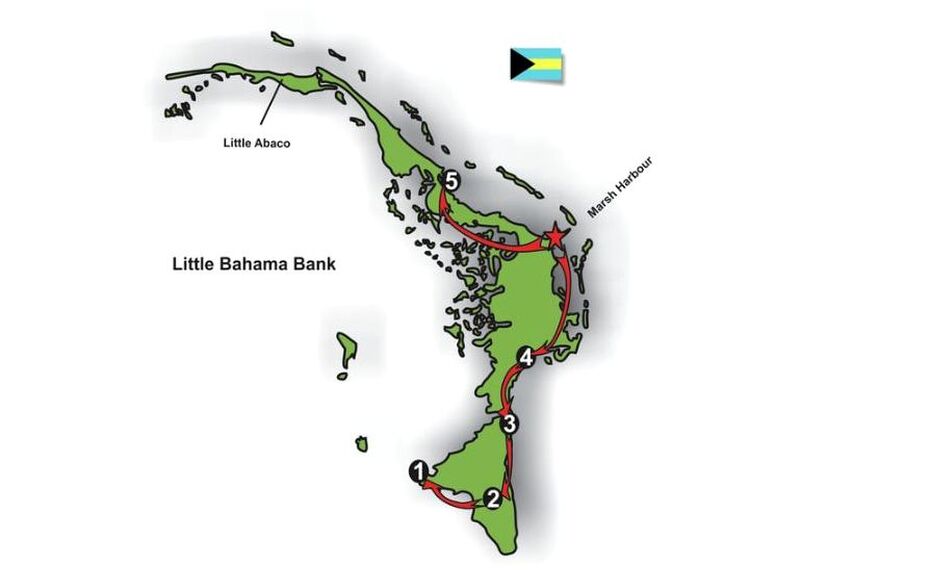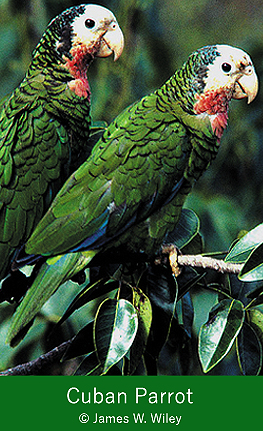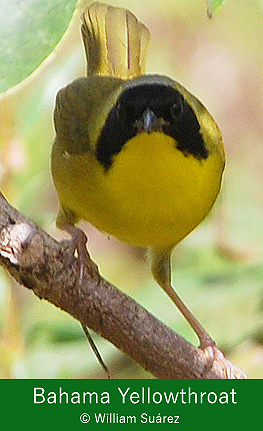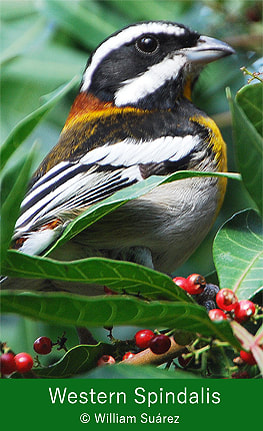<< BAHAMAS BIRDING TOURS
A relaxing, all inclusive short birding tour to the Bahamas that includes the endemic Bahama Woodstar, Bahama Swallow, Bahama Yellowthroat, Bahama Warbler plus some Cuban species such as Cuban Parrot, Cuban Emerald, La Sagra's Flycatcher, Cuban Pewee and more!
Quick Info Literature & Audio Photo Gallery Bird Checklist COVID-19
|
The Bahama Islands comprise the northernmost archipelago of the West Indies, covering an area of about 2,300 square miles (5,957 square kilometers) with more than a thousand low-lying islands, all located approximately just north of the western half of the Greater Antillean chain formed by Cuba, Hispaniola, and Puerto Rico. It was in the Bahamas, at San Salvador, where Christopher Columbus and his Spanish crew first touched the New World and recorded the first sighting of an American bird and native people.
Today, the Bahamian avifauna comprises more than 370 recorded species. This avifauna is strongly influenced by the bird fauna of the Greater Antilles (mostly Cuba), and by that of North America. Ten Bahamian birds species are globally threatened and six are endemic to the archipelago, including Bahama Woodstar (Nesophlox evelynae), Inagua Woodstar (N. lyrura), Bahama Swallow (Tachycineta cyaneoviridis), Bahama Yellowthroat (Geothlypis rostrata), Bahama Warbler (Setophaga flavescens) and Bahama Oriole (Icterus northropi). About 190 species breed in the archipelago and over 170 additional species have been recorded during migration. Located in the Little Bahama Bank, Abaco is the second largest island in the Bahamas, after Andros. Both islands are part of the northern section of the subdivision of the archipelago. Abaco provides an excellent opportunity to conduct birding activities, as most of the endemic species and specialties of the Bahamas occur there (see Bird Checklist). Our birding tours to Great Abaco Island are short, relaxing birding programs that include visits to most of the island's habitats, including those of the exquisitely colored resident race of the Cuban Parrot (Amazona leucocephala bahamensis) and spectacularly beautiful male of the northern race of the Western Spindalis (Spindalis zena townsendi). |
Abaco
Main Localities: 1) Sandy Point, 2) Abaco National Park, 3) Crossing Rock, 4) Bahama Palm Shores, 5) Treasure Cay
DAY 1: Welcome to our Birding Tours to the BahamasArrival on Great Abaco and transfer from Marsh Harbour Airport (MHH). We will be waiting for you at the airport for your transportation to the hotel, where members of the group will check into their reserved rooms. Time permitting and depending of arrival of members of the group, a welcome and introductory birding session will be conducted during the afternoon in the vicinity of Marsh Harbour. At 6:00 p.m. participants will meet the leader in the lobby for discussion of trip plans before dinner. Night in Marsh Harbour.
DAY 2-3: Southern section of Great Abaco (Bahama Palm Shores, Crossing Rock, Abaco National Park, & Sandy Point)After breakfast at the hotel, we will depart for birding in the southern region of Great Abaco, passing through one of the narrowest parts of the island, where Long Beach is located. South of the Crossing Rock, most of the region is extensively covered with Caribbean pine forest (Abaco National Park). Here we will find the Bahama race of the Cuban Parrot, which nests in solution holes in the ground rather than in tree cavities!
Our target birds in this region include most of the endemics and specialties, such as the Bahama Woodstar, Cuban Emerald, West Indian Woodpecker, the Cuban race of the American Kestrel, Cuban Pewee, La Sagra's Flycatcher, Loggerhead Kingbird, Thick-billed Vireo, Bahama Swallow, Red-legged Thrush, Bahama Yellowthroat, Olive-capped Warbler, Bahama Warbler, Bananaquit, Western Spindalis, Black-faced Grassquit, and Greater Antillean Bullfinch, among others. Reaching the Sandy Point settlement, we will search the mangrove habitat for the Cuban race of the Yellow Warbler. Pelicans, shorebirds, herons, gulls, and terns are present as well, including some plovers, sandpipers, willets, and dowitchers. After lunch in this part of the island, we will head north to Bahama Palm Shores, where we are likely to encounter Cuban Parrots. Time permitting, we will visit other localities along the way for good views of several duck species. After finishing our observations, we will return to the hotel. Night in Marsh Harbour. DAY 4: Northwestern section of Great Abaco (Marsh Harbour to Treasure Cay)This morning we will continue our birding activities, starting at Treasure Cay, on the northwestern wing of Great Abaco Island. This day is primarily geared to complete our growing birding list for the island, but we will also have additional chances to closely observe those species previously listed that need better views. We will check some lagoons as well as pine woods, where passerines (especially warblers) are active.
During our visit at Treasure Cay, White-cheeked Pintail, Least Grebe, Least Bittern, gulls, Smooth-billed Ani, blackbirds, and more, can be add to the list. Our afternoon will be devoted to birding in the vicinity of Marsh Harbour, on the grounds of Great Abaco Beach Resort, and from there to Albury's Ferry Dock. Along the way, Mangrove Cuckoo and the endemic race of Hairy Woodpecker can be found. Here, we conclude our ornithological explorations in Great Abaco. Night in Marsh Harbour. DAY 5: Good-bye & Departure from the Bahamas (Great Abaco Island)Transfer from the hotel to Marsh Harbour Airport (MHH) for departures of the members of the group.
|
Alterations in Tour Itineraries: Owing to a variety of circumstances, a planned itinerary as appears on this website, can be changed or modified locally by the leader to accommodate particular weather conditions, bird activity, human disturbances, unexpected situations, or any other reasons considered by the leader. WILLIAM SUAREZ BIRDING TOURS reserves the right to change any itinerary.




